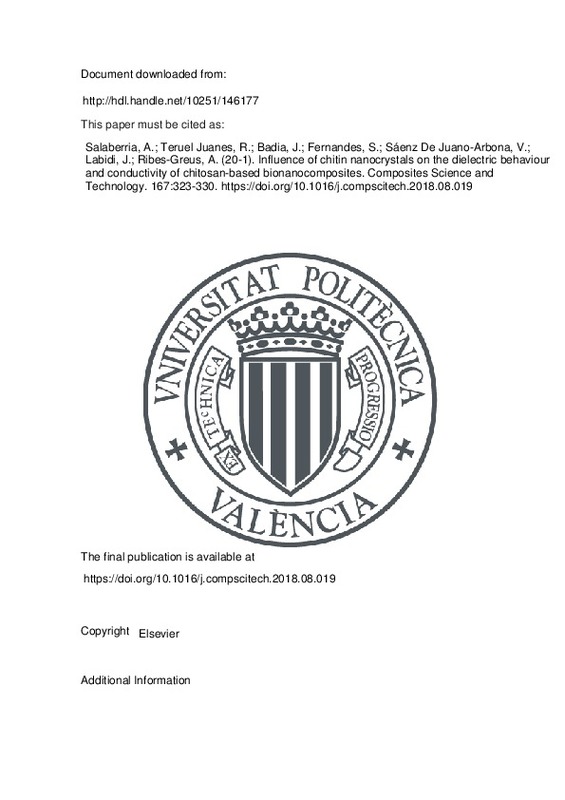JavaScript is disabled for your browser. Some features of this site may not work without it.
Buscar en RiuNet
Listar
Mi cuenta
Estadísticas
Ayuda RiuNet
Admin. UPV
Influence of chitin nanocrystals on the dielectric behaviour and conductivity of chitosan-based bionanocomposites
Mostrar el registro sencillo del ítem
Ficheros en el ítem
| dc.contributor.author | Salaberria, A.M.
|
es_ES |
| dc.contributor.author | TERUEL JUANES, ROBERTO
|
es_ES |
| dc.contributor.author | Badia, J.D.
|
es_ES |
| dc.contributor.author | Fernandes, S.C.M.
|
es_ES |
| dc.contributor.author | Sáenz de Juano-Arbona, V.
|
es_ES |
| dc.contributor.author | Labidi, J.
|
es_ES |
| dc.contributor.author | Ribes-Greus, A.
|
es_ES |
| dc.date.accessioned | 2020-06-12T03:33:50Z | |
| dc.date.available | 2020-06-12T03:33:50Z | |
| dc.date.issued | 2018-10-20 | es_ES |
| dc.identifier.issn | 0266-3538 | es_ES |
| dc.identifier.uri | http://hdl.handle.net/10251/146177 | |
| dc.description.abstract | [EN] A series of bionanocomposite films based on chitosan, reinforced with chitin nanocrystals, were developed, and assessed in terms of dielectric behaviour and conductivity by using an experimental methodology that allows avoiding the conductivity contribution and the exclusion of contact and interfacial polarization effects. The dielectric relaxations at low and high frequency and temperatures were modeled by Havriliak-Negami functions. Below the glass transition temperature (Tg), the gamma and beta relaxations were observed, which were related to intramolecular and non-cooperative segmental movements. At higher temperatures, an intermolecular and cooperative macromolecular movement, related to the glass transition, gave rise to alpha-relaxation. In addition, two over-Tg p(I) and p(II) relaxations were found, which were related to the displacement of dipoles in the disordered structure of bionanocomposites. The addition of chitin nanocrystals did not affect the apparent activation energy Ea of the gamma-relaxation. However, it decreased the Ea of the beta-relaxation and increased the free volume at temperatures in the vicinities of the alpha-relaxation. Finally, the electric conductivity of the bionanocomposites was lower than that of neat chitosan and chitin due to the interaction between the-OH and-NH2 groups that reduced the ionic mobility, along with the increase of free volume, with the subsequent separation of phases. | es_ES |
| dc.description.sponsorship | The European Regional Development Funds and the Spanish Ministry of Science and Innovation for the concession of Research Projects ENE2014-53734-C2-1-R, UPOV13-3E-1947 and ENE2017-86711-C3-1-R are appreciated. Generalitat Valenciana is acknowledged for the project APOSTD14/041 for JD Badia and GRISOLIA/2002/003 for R. Teruel-Juanes. The authors are thankful for the financial support from the Department of Education of the Basque Government (IT1008-18). | es_ES |
| dc.language | Inglés | es_ES |
| dc.publisher | Elsevier | es_ES |
| dc.relation.ispartof | Composites Science and Technology | es_ES |
| dc.rights | Reserva de todos los derechos | es_ES |
| dc.subject | Bionanocomposites | es_ES |
| dc.subject | Material testing | es_ES |
| dc.subject | Dielectric thermal analysis (DETA) | es_ES |
| dc.subject | Chitosan | es_ES |
| dc.subject | Chitin nanocrystals | es_ES |
| dc.subject.classification | MAQUINAS Y MOTORES TERMICOS | es_ES |
| dc.subject.classification | INGENIERIA DE LOS PROCESOS DE FABRICACION | es_ES |
| dc.title | Influence of chitin nanocrystals on the dielectric behaviour and conductivity of chitosan-based bionanocomposites | es_ES |
| dc.type | Artículo | es_ES |
| dc.identifier.doi | 10.1016/j.compscitech.2018.08.019 | es_ES |
| dc.relation.projectID | info:eu-repo/grantAgreement/MINECO//UPOV13-3E-1947/ES/Cromatrografía por Exclusión de Tamaños/ | es_ES |
| dc.relation.projectID | info:eu-repo/grantAgreement/GVA//GRISOLIA%2F2002%2F003/ | es_ES |
| dc.relation.projectID | info:eu-repo/grantAgreement/Eusko Jaurlaritza//IT1008-18/ | es_ES |
| dc.relation.projectID | info:eu-repo/grantAgreement/GVA//APOSTD%2F2014%2F041/ | es_ES |
| dc.relation.projectID | info:eu-repo/grantAgreement/MINECO//ENE2014-53734-C2-1-R/ES/DISEÑO Y VALIDACION DE MEMBRANAS CON CONTROL MORFOLOGICO PARA SU USO EN PILAS DE COMBUSTIBLE DE BAJA TEMPERATURA SOSTENIBLES EN VEHICULOS EFICIENTES NO TRIPULADOS/ | es_ES |
| dc.relation.projectID | info:eu-repo/grantAgreement/AEI/Plan Estatal de Investigación Científica y Técnica y de Innovación 2013-2016/ENE2017-86711-C3-1-R/ES/SISTEMA INTEGRADO DE DESCARBONIZACION Y PRODUCCION DE ENERGIA BASADO EN PILAS DE COMBUSTIBLE DE METANOL DIRECTO PARA APLICACIONES NAVALES Y AEROESPACIALES/ | es_ES |
| dc.rights.accessRights | Abierto | es_ES |
| dc.contributor.affiliation | Universitat Politècnica de València. Instituto de Tecnología de Materiales - Institut de Tecnologia de Materials | es_ES |
| dc.contributor.affiliation | Universitat Politècnica de València. Departamento de Máquinas y Motores Térmicos - Departament de Màquines i Motors Tèrmics | es_ES |
| dc.description.bibliographicCitation | Salaberria, A.; Teruel Juanes, R.; Badia, J.; Fernandes, S.; Sáenz De Juano-Arbona, V.; Labidi, J.; Ribes-Greus, A. (2018). Influence of chitin nanocrystals on the dielectric behaviour and conductivity of chitosan-based bionanocomposites. Composites Science and Technology. 167:323-330. https://doi.org/10.1016/j.compscitech.2018.08.019 | es_ES |
| dc.description.accrualMethod | S | es_ES |
| dc.relation.publisherversion | https://doi.org/10.1016/j.compscitech.2018.08.019 | es_ES |
| dc.description.upvformatpinicio | 323 | es_ES |
| dc.description.upvformatpfin | 330 | es_ES |
| dc.type.version | info:eu-repo/semantics/publishedVersion | es_ES |
| dc.description.volume | 167 | es_ES |
| dc.relation.pasarela | S\379304 | es_ES |
| dc.contributor.funder | Generalitat Valenciana | es_ES |
| dc.contributor.funder | Agencia Estatal de Investigación | es_ES |
| dc.contributor.funder | Gobierno Vasco/Eusko Jaurlaritza | es_ES |
| dc.contributor.funder | Ministerio de Economía y Empresa | es_ES |
| dc.contributor.funder | European Regional Development Fund | es_ES |
| dc.contributor.funder | Ministerio de Economía y Competitividad | es_ES |







![[Cerrado]](/themes/UPV/images/candado.png)

